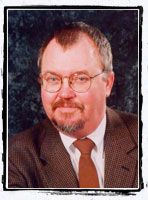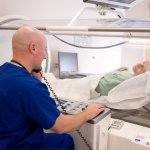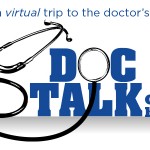By Gwen Rockwood
Until last week, every time I heard the word “osteoporosis,” a picture of a frail little old lady hunched over a cane popped into my head. But I’m not a frail little old lady, so I assumed it wasn’t something I needed to think about yet.
 Then I sat down with Dr. Lindley Diacon, who performs bone density scans at Mercy Medical Clinic in Rogers, and I realized that it’s what we don’t know about osteoporosis that puts us most at risk for becoming that frail, little old lady many of us associate with the disease. If you don’t care about osteoporosis until you’re old, you’re way too late to do much about it.
Then I sat down with Dr. Lindley Diacon, who performs bone density scans at Mercy Medical Clinic in Rogers, and I realized that it’s what we don’t know about osteoporosis that puts us most at risk for becoming that frail, little old lady many of us associate with the disease. If you don’t care about osteoporosis until you’re old, you’re way too late to do much about it.
Protect your kids
The good news is there’s a lot you can do to prevent the disease not only for yourself but also for your children. “What most people don’t know about osteoporosis is that it originates in childhood,” Dr. Diacon said. “Your children’s best chance of avoiding the disease later in life is based largely on what you feed them and the amount and type of exercise you make sure they get.”
From the age of 9 to 18, kids are in their peak bone-building years. The stronger their bones grow during this time frame, the better their chances are for preventing osteoporosis later in life. Dr. Diacon recommended three things parents should do to help their kids build bone: 1) Feed them 1200 to 1300 milligrams of calcium each day. 2) Make sure they get enough Vitamin D. 3) Make sure they get enough weight-bearing exercise.
Calcium: The good news is that it doesn’t all have to come from milk. “You can be lactose intolerant and still get plenty of calcium in your diet,” Diacon said. To help you determine how much and what types of food will get your child to that magic 1200 milligram number, click on this link for a list of foods and their calcium content, and remember to read food labels: ONLINE CALCIUM COUNTER
Vitamin D: Often called the “sunshine vitamin,” vitamin D is critical for helping your body absorb calcium. “Sunlight is the ideal source for vitamin D, and only 20 to 30 minutes a day during non-peak intensity hours is usually sufficient,” Dr. Diacon said. Check with your doctor to get his or her recommendations on sun exposure.
Exercise: In the past, kids got plenty of exercise through normal outdoor play. But with the emergence of video games and more stationary pastimes, running and playing outside isn’t nearly as common as it once was. Dr. Diacon says this lack of exercise across a generation of kids could snowball into a big problem in years to come because kids aren’t building strong bones in childhood. “I’m concerned that we may one day have an epidemic of osteoporosis,” Diacon said.
How much exercise is enough? Dr. Diacon said parents should make sure their kids get at least 30 minutes of weight-bearing activity every day. But they don’t have to take aerobics at the gym. Walking, playing chase with Mom in the yard, climbing at the park – it all helps build bone.
Generally speaking, moms are pretty good at looking out for their kids. They’re also good at taking care of their aging parents. But taking care of themselves often falls to the bottom of the list. In order to stay strong into advanced age, Dr. Diacon says the period between the age of 30 and menopause is absolutely critical for preventing the onset of osteoporosis. “By the time women hit 30, they stop building bone,” Diacon said. “So it’s important that women over 30 are getting enough calcium, Vitamin D and exercise so they can maintain and strengthen their bones because, after menopause, they can lose as much as five to 10 percent of their bone mass due to the lack of estrogen.”
If you’re not getting enough calcium in your food or enough sunlight exposure for Vitamin D, talk to your doctor about supplements.
Why it matters
Osteoporosis has never had and may not ever get the level of media attention diseases like cancer and heart disease receive. It’s a silent, slow disease people often don’t know is there until that first bone breaks. But its effects are just as devastating and are often deadly. Twenty-four percent of people who suffer a hip fracture over the age of 50 will die in the year following the fracture, according to statistics from the National Osteoporosis Foundation. One in five of them will never live alone again. Six months after a hip fracture, only 15 percent of patients can walk across a room without help. “It’s a huge quality of life issue,” said Dr. Diacon, who knows first-hand how the disease affects families. Both of his grandmothers died of complications from a hip fracture.
“Don’t wait for a symptom to tip you off that there may be a problem,” Dr. Diacon said. “There aren’t very many warning signals until the damage is already done.” Certain groups are more at risk for the disease, including women, Caucasians, those with history of a maternal hip fracture, those who are small and thin, those with a history of broken bones, and smokers.
What you should do
At age 65, everyone should have a DXA bone density test, considered the gold standard for determining the risk of osteoporosis. The test is painless and involves lying on an exam table for five to 10 minutes and involves much less radiation than a typical chest x-ray. Dr. Diacon said it’s a good idea for women at menopause to have a bone density test in order to establish a baseline so her doctor can track her bone health over time.
Before you get a bone density test, ask if your examiner is ISCD certified (International Society for Clinical Densitometry). Mercy Health System’s imaging department is one of only 20 facilities nationwide that’s fully accredited. Dr. Diacon also recommends having the bone density test and any necessary treatment done at the same facility, using the same examiners and testing equipment to ensure better precision rates.
When he speaks to women’s groups, Dr. Diacon says there’s one startling statistic that always gets his audience’s full attention. “One out of every two women over the age of 50 will experience a fracture related to osteoporosis,” said Dr. Diacon. What you do right now will help determine if that woman ends up being the lady next to you – or you.
For more facts about osteoporosis, visit the National Osteoporosis Foundation by clicking here.





